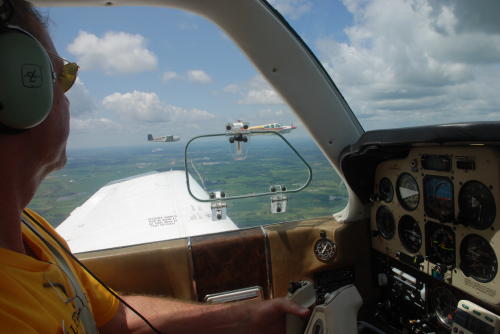| Oshkosh - Formation Flight Information |
| Click here to view in Adobe Acrobat PDF format for easier printing. |
|
| Engine Start & Taxi |
| This will be announced at the briefing. Anticipated start time is 11:45 a.m. local time for a noon departure. You should have checked your oil, tire pressure and other preflight necessities prior to the briefing. Taxi instructions will be given at the briefing. All transponders must be on standby or off. Be especially vigilant for pedestrians (especially children) in this active ramp area. |
| Runway protocol |
| DO NOT EVEN THINK OF SHUTTING DOWN YOUR ENGINE WHILE WAITING FOR DEPARTURE. |
| Run-up |
| We strongly recommend you do your mag check at cruise power prior to landing or on the ground before getting to the UPS ramp - you will then be ready to go without a run-up with the next engine start. If you feel you must do a run-up
on the ground after engine start: do it on the ramp where you have more spacing than you will have anywhere else, do it at the lowest possible RPM and cycle your prop only once. Once we start to taxi there is no time or place appropriate for run-up.
Certainly do not do a run-up on the runway when tail to nose and only two feet from the Bonanza behind you. If your airplane is prone to overheating at idle for 15-20 minutes do everyone a favor and drop out of the formation. One airplane running down a battery while attempting a hot start will ruin the flight for everyone. There will be no way to get around you. You probably will not be able to run fast enough to get away from the angry mob. Again, do not do your run up on the runway. We are lined up nose to tail only a few feet apart. If leaned on the runway waiting for take-off richen the mixture slowly to avoid flooding the engine. |
| Takeoff |
| All planes will be lined up three abreast on the runway prior to take-off if landing Runway 36 L&R. Planes will line up two abreast for all other runway arrivals. Each element leader will begin take-off roll when signaled by flagman. Wingmen will watch their lead for signal for brake release. |
| Enroute Speeds |
|
||||||||||||
| Element Spacing |
| Flight leader spacing is an art, not an exact science. Your flight lead will use his judgment. If hazy he may be closer. If very clear he may elect additional spacing for lesser turbulence. His speed adjustments will be as gradual as possible and as little as necessary to achieve the desired spacing. If turbulent try sliding a little sideways to avoid prop wash from the plane in front - slight shift may do the trick. |
| Wingman Position |
| Wingmen should be sufficiently forward that the Flight Leader can easily see them. If you are more comfortable with a little extra spacing, then move laterally. Avoid falling back or forming a deep ‘V’ in the formation. If you see someone in the element in front falling back, just slide further in or out as need be. Eventually the culprit will catch up. | ||
|
||
| Route |
| This is a VFR flight. Element leads are expected to follow the element in front of them, not a GPS track. Wingmen are expected to stay with their element lead. In deference to copilots who want something to do, the routes are published. Formation Flight Lead may vary the route depending on weather. In 2001 we were on the planned route only 40% of the time. Nothing is cast in stone. Being a pilot is being flexible, but formation flying means discipline - follow lead. It is the formation lead's job to be flexible. |
| Route GPS DB |
|
Routing has been changed completely. With database waypoints universally present in every GPS we are utilizing waypoints already in almost every GPS.
Some units apparently do not have OKDOE in the database, possibly because of older database or approach fixes. Lat/Lon for this fix is as follows. Numbers in parentheses are seconds if your GPS uses those rather than hundredths - substitute for the last two digits: OKDOE: N44.05.87 (52) W088.32.25 (15) |
| Route Comments |
| We will not know the route until the 10.00 a.m. briefing. Our preferred arrival runway at OSH is RW 36 unless winds dictate otherwise. The RW 36 arrival is our standard three aircraft formation. All other runway arrivals will be two aircraft elements from departure to touchdown. |
| Radios |
| Frequencies will be given at the briefing. Radio silence is mandatory. As they say in the T-34 manual, ‘Wingman, the only thing I ever want to hear you say is 'Lead, you are on fire!'‘ You can not have a stuck mike if you don't use it. Be sure you are not leaning against a hand-held mike button. |
| Approach Waypoints |
| Click on titles to see the routes in a Graphical representation |
|
|
|||||||||||||||||||||||||||||||||||||||||||||
|
|
|||||||||||||||||||||||||||||||||||||||||||||
|
|
|||||||||||||||||||||||||||||||||||||||||||||
Southern California Pilots Association ▪ 25316 Stageline Dr, Laguna Hills, CA 92653 ▪ Phone: (949) 322-4397
© 1990-2024 Stephen Blythe - This Web Site is hosted by BlytheAir: Laguna Hills, CA ▪ (949) 445-8181
